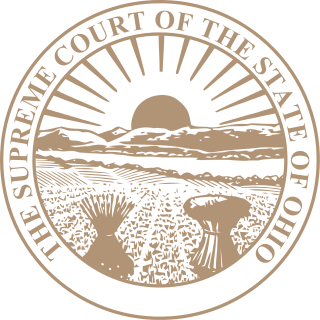Respondeat superior is a doctrine that a party is responsible for acts of his agents. For example, in the United States, there are circumstances when an employer is liable for acts of employees performed within the course of their employment. This rule is also called the master-servant rule, recognized in both common law and civil law jurisdictions.
In law, liable means "responsible or answerable in law; legally obligated". Legal liability concerns both civil law and criminal law and can arise from various areas of law, such as contracts, torts, taxes, or fines given by government agencies. The claimant is the one who seeks to establish, or prove, liability.
Vicarious liability is a form of a strict, secondary liability that arises under the common law doctrine of agency, respondeat superior, the responsibility of the superior for the acts of their subordinate or, in a broader sense, the responsibility of any third party that had the "right, ability or duty to control" the activities of a violator. It can be distinguished from contributory liability, another form of secondary liability, which is rooted in the tort theory of enterprise liability because, unlike contributory infringement, knowledge is not an element of vicarious liability. The law has developed the view that some relationships by their nature require the person who engages others to accept responsibility for the wrongdoing of those others. The most important such relationship for practical purposes is that of employer and employee.

English tort law concerns the compensation for harm to people's rights to health and safety, a clean environment, property, their economic interests, or their reputations. A "tort" is a wrong in civil law, rather than criminal law, that usually requires a payment of money to make up for damage that is caused. Alongside contracts and unjust enrichment, tort law is usually seen as forming one of the three main pillars of the law of obligations.
Negligence in employment encompasses several causes of action in tort law that arise where an employer is held liable for the tortious acts of an employee because that employer was negligent in providing the employee with the ability to engage in a particular act. Four basic causes of action may arise from such a scenario: negligent hiring, negligent retention, negligent supervision and negligent training. While negligence in employment may overlap with negligent entrustment and vicarious liability, the concepts are distinct grounds of liability. The doctrine that an employer is liable for torts committed by employees within the scope of their employment is called respondeat superior.

London Drugs Ltd v Kuehne & Nagel International Ltd, [1992] 3 SCR 299 is a leading decision of the Supreme Court of Canada on privity of contract.
Negligent entrustment is a cause of action in United States tort law which arises where one party is held liable for negligence because they negligently provided another party with a dangerous instrumentality, and the entrusted party caused injury to a third party with that instrumentality. The cause of action most frequently arises where one person allows another to drive their automobile.
Vicarious liability in English law is a doctrine of English tort law that imposes strict liability on employers for the wrongdoings of their employees. Generally, an employer will be held liable for any tort committed while an employee is conducting their duties. This liability has expanded in recent years following the decision in Lister v Hesley Hall Ltd to better cover intentional torts, such as sexual assault and deceit. Historically, it was held that most intentional wrongdoings were not in the course of ordinary employment, but recent case law suggests that where an action is closely connected with an employee's duties, an employer can be found vicariously liable. The leading case is now the Supreme Court decision in Catholic Child Welfare Society v Institute of the Brothers of the Christian Schools, which emphasised the concept of "enterprise risk".

Lister v Hesley Hall Ltd [2001] UKHL 22 is an English tort law case, creating a new precedent for finding where an employer is vicariously liable for the torts of their employees. Prior to this decision, it had been found that sexual abuse by employees of others could not be seen as in the course of their employment, precluding recovery from the employer. The majority of the House of Lords however overruled the Court of Appeal, and these earlier decisions, establishing that the "relative closeness" connecting the tort and the nature of an individual's employment established liability.

Honeywill and Stein Ltd v Larkin Brothers Ltd [1934] 1 KB 191 is an English tort law case, establishing that employers may be vicariously liable for damage done by their independent contractors, where they carry out 'extra-hazardous' activities. Generally, employers are only vicariously liable for the torts of their employees, and not for those of independent contractors. However, a non-delegable duty may be imposed on an employer where they contract for inherently dangerous activities to be undertaken.

Rose v Plenty [1976] 1 WLR 141 is an English tort law case, on the issue of where an employee is acting within the course of their employment. Vicarious liability was tenuously found under John William Salmond's test for course of employment, which states that an employer will be held liable for either a wrongful act they have authorised, or a wrongful and unauthorised mode of an act that was authorised.

Doe v Bennett, 2004 SCC 17 is a legal ruling by the Supreme Court of Canada which upheld the lower court's decision that the ecclesiastical corporation, Roman Catholic Episcopal Corporation of St. George's in Western Newfoundland, was vicariously liable for sexual abuse by Father Kevin Bennett.

Bazley v Curry, [1999] 2 SCR 534 is a Supreme Court of Canada decision on the topic of vicarious liability where the Court held that a non-profit organization may be held vicariously liable in tort law for sexual misconduct by one of its employees. The decision has widely influenced jurisprudence on vicarious liability outside of Canada.

Majrowski v Guy's and St Thomas' NHS Trust [2006] UKHL 34 is a UK labour law case holding that an employer will be vicariously liable for the harassment of an employee by another.
Fourway Haulage SA (Pty) Ltd v SA National Roads Agency Ltd is an important case in South African law. It was heard in the Supreme Court of Appeal on 5 November 2008, with judgment handed down on 26 November. The judges were Scott JA, Farlam JA, Brand JA, Lewis JA and Jafta JA. JH Dreyer SC appeared for the appellant, and AC Ferreira SC for the respondent.
Dubai Aluminium Co Ltd v Salaam [2002] UKHL 48 is an English vicarious liability case, concerning also breach of trust and dishonest assistance.

Viasystems (Tyneside) Ltd v Thermal Transfer (Northern) Ltd[2005] EWCA Civ 1151 is an English tort law and UK labour law case, which held that a worker can have more than one employer at the same time, who will be vicariously liable for the worker.
K v Minister of Safety and Security is an important case in the South African law of delict and South African constitutional law. It was heard by the Constitutional Court on May 10, 2005, with judgment handed down on June 13. Langa CJ, Moseneke DCJ, Madala J, Mokgoro J, O'Regan J, Sachs J, Skweyiya J, Van der Westhuizen J and Yacoob J presided. W. Trengove SC appeared for the applicant; PF Louw SC appeared for the respondent. The applicant's counsel was instructed by the Women's Legal Centre, Cape Town. The respondent's attorney was the State Attorney, Johannesburg.

Kerans v. Porter Paint Co. was a leading case in Ohio on employer liability for workplace sexual harassment. In an opinion by Alice Robie Resnick, the court held that victims of harassment could bring tort claims against their employers. Resnick held that the psychological and emotional damages suffered by victims of harassment were not injuries under Ohio's workers' compensation statute, and employers were vicariously liable for the sexual harassment of their employees when they knew or should have known about the harassment.

Hickey v McGowan & ors, [2017] IESC 6 is a reported Irish Supreme Court case decision. This case concerns child abuse and vicarious liability. The second defendant sexually abused the plaintiff in class, in the presence of the other students. This happened at least once a week. Four boys who witnessed the abuse in the class gave evidence, which was accepted by the High Court. It was determined that there must be a "close connection" between the wrongful act and the actions that one had engaged the offender to perform in order for one to be made liable for the act of another.








